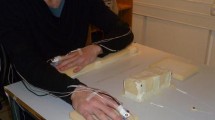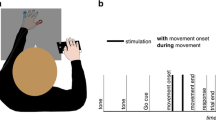Abstract
We present two experiments in which we investigated whether tactile attention is modulated by action preparation. In Experiment 1, participants prepared a saccade toward either the left or right index finger, depending on the pitch of a non-predictive auditory cue. In Experiment 2, participants prepared to lift the left or right index finger in response to the auditory cue. In half of the trials in both experiments, a suprathreshold vibratory stimulus was presented with equal probability to either finger, to which the participants made a speeded foot response. The results showed facilitation in the processing of targets delivered at the goal location of the prepared movement (Experiment 1), as well as at the effector of the prepared movement (Experiment 2). These results are discussed within the framework of theories on motor preparation and spatial attention.



Similar content being viewed by others
References
Baldauf D, Deubel H (2006) Deployment of visual attention before sequences of goal-directed hand movements. Vis Res 46:4355–4374
Baldauf D, Deubel H (2008) Visual attention during the preparation of bimanual movements. Vis Res 48:549–563
Bays PM, Wolpert DM, Flanagan JR (2005) Perception of the consequences of self-action is temporally tuned and event-driven. Curr Biol 15:1125–1128
Blakemore S-J, Frith CD, Wolpert DM (1999) Spatio-temporal prediction modulates the perception of self-produced stimuli. J Cogn Neurosci 11:551–559
Bremmer F, Schlack A, Shah NJ, Zafiris O, Kubischik M, Hoffman K-P, Zilles K, Fink GR (2001) Polymodal motion processing in posterior parietal and premotor cortex: a human fMRI study strongly implies equivalences between humans and monkeys. Neuron 29:287–296
Chambers CD, Stokes MG, Mattingley JB (2004) Modality-specific control of strategic spatial attention in parietal cortex. Neuron 44:925–930
Cohen YE, Andersen RA (2004) Multimodal spatial representations in the primate parietal lobe. In: Spence C, Driver J (eds) Crossmodal space and crossmodal attention. Oxford University Press, Oxford, pp 99–122
Colby CL (1998) Action-oriented spatial reference frames in cortex. Neuron 20:15–24
Deubel H, Schneider WX (1996) Saccade target selection and object recognition: evidence for a common attentional mechanism. Vis Res 36:1827–1837
Deubel H, Schneider WX, Paprotta I (1998) Selective dorsal and ventral processing: evidence for a common attentional mechanism in reaching and perception. Vis Cogn 5:81–107
Diederich A, Colonius H, Bockhorst D, Tabeling S (2003) Visual–tactile spatial interaction in saccade generation. Exp Brain Res 148:328–337
Eimer M (2001) Crossmodal links in spatial attention between vision, audition, and touch: evidence from event-related brain potentials. Neuropsychologia 39:1292–1303
Eimer M, van Velzen J (2002) Crossmodal links in spatial attention are mediated by supramodal control processes: evidence from event-related potentials. Psychophysiology 39:437–449
Eimer M, van Velzen J, Forster B, Driver J (2003) Shifts of attention in light and in darkness: and ERP study of supramodal attention control and crossmodal links in spatial attention. Cogn Brain Res 15:308–323
Eimer M, Forster B, van Velzen J, Prabhu G (2005) Covert manual response preparation triggers attentional shifts: ERP evidence for the premotor theory of attention. Neuropsychologia 43:957–966
Farah MJ, Wong AB, Monheit MA, Morrow MA (1989) Parietal lobe mechanisms of spatial attention: modality-specific or supramodal? Neuropsychologia 27:461–470
Fogassi L, Gallese V (2004) Action as a binding key to multisensory integration. In: Calvert GA, Spence C, Stein BA (eds) The handbook of multisensory processes. MIT Press, Cambridge, pp 425–441
Forster B, Eimer M (2007) Covert unimanual response preparation triggers attention shifts to effectors rather than goal locations. Neurosci Lett 419:142–146
Gherri E, Eimer M (2008) Links between eye-movement preparation and the attentional processing of tactile events: an event-related brain potential study. Clin Neurophysiol 119:2587–2597
Graziano MSA, Gross CG (1996) Multiple pathways for processing visual space. In: Inui T, McClelland JL (eds) Attention and performance XVI. MIT Press, Cambridge, pp 181–207
Graziano MSA, Gross CG, Taylor CSR, Moore T (2004) A system of multimodal areas in the primate brain. In: Spence C, Driver J (eds) Crossmodal space and crossmodal attention. Oxford University Press, Oxford, pp 51–68
Groh JM, Sparks DL (1996a) Saccades to somatosensory targets. I. Behavioral characteristics. J Neurophysiol 75:412–427
Groh JM, Sparks DL (1996b) Saccades to somatosensory targets. III. Eye-position dependent somatosensory activity in primate superior colliculus. J Neurophysiol 75:439–453
Hoffman JE, Subramaniam B (1995) The role of visual attention in saccadic eye movements. Perception Psychophys 57:787–795
Kennett S, Taylor-Clarke M, Haggard P (2001) Noninformative vision improves the spatial resolution of touch in humans. Curr Biol 11:1188–1191
Kowler E, Anderson E, Dosher B, Blaser E (1995) The role of attention in the programming of saccades. Vis Res 35:1897–1916
Lloyd D, Merat N, McGlone F, Spence C (2003) Crossmodal links between audition and touch in covert endogenous spatial attention. Percept Psychophys 65:901–924
Rizzolatti G, Riggio L, Sheliga B (1994) Space and selective attention. In: Umiltà C, Moscovitch M (eds) Attention and performance XV. MIT Press, Cambridge, pp 231–265
Rizzolatti G, Luppino G, Matelli M (1998) The organization of the cortical motor system: new concepts. Electroencephalograph Clin Neurophysiol 106:283–296
Rorden C, Greene K, Sasine GM, Baylis GC (2002) Enhanced tactile performance at the destination of an upcoming saccade. Curr Biol 12:1–6
Shergill SS, Bays PM, Frith CD, Wolpert DM (2003) Two eyes for an eye: the neuroscience of force escalation. Science 301:187
Spence C, Driver J (1996) Audiovisual links in endogenous covert spatial attention. JEP:HPP 22:1005–1030
Spence C, Driver J (2004) Crossmodal space and crossmodal attention. Oxford University Press, Oxford
Spence C, Pavani F, Driver J (2000) Crossmodal links between vision and touch in covert endogenous attention. JEP:HPP 26:1298–1319
Spence C, Pavani F, Maravita A, Holmes N (2008) Multisensory contributions to the representation of peripersonal space in humans: evidence from the crossmodal congruency task. In: Lin M (ed) Haptic rendering: foundations, algorithms, and applications. AK Peters, Wellesley, pp 27–69
Tipper SP, Lloyd D, Shorland D, Howard LA, McGlone F (1998) Vision influences tactile perception without proprioceptive orienting. Neuroreport 9:1741–1744
Voss M, Ingram JN, Haggard P, Wolpert DM (2006) Sensorimotor attenuation by central motor command signals in the absence of movement. Nat Neurosci 9:26–27
Whang KC, Burton H, Shulman GL (1991) Selective attention in vibrotactile tasks: detecting the presence and absence of amplitude change. Percept Psychophys 50:157–165
Wolpert DM, Flanagan JR (2001) Motor prediction. Curr Biol 18:R729–R732
Acknowledgments
This research was funded by the Cluster of Excellence ‘Cognition in Technical Systems’ (Project 301) and by the 7th Framework Programme of the European Community (Project “GRASP”, ICT-215821).
Author information
Authors and Affiliations
Corresponding author
Rights and permissions
About this article
Cite this article
Juravle, G., Deubel, H. Action preparation enhances the processing of tactile targets. Exp Brain Res 198, 301–311 (2009). https://doi.org/10.1007/s00221-009-1819-0
Received:
Accepted:
Published:
Issue Date:
DOI: https://doi.org/10.1007/s00221-009-1819-0




